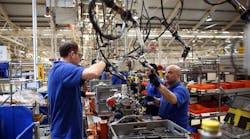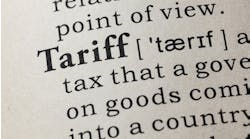U.K. manufacturers extended their winning streak in October as foreign demand sent car production to a record, according to figures published on Dec. 8.
Factory output rose 0.1% from September, marking six consecutive increases for the first time since modern records began in 1997, the Office for National Statistics said. Overall industrial production was unchanged as warmer weather reduced demand for energy.
But the start of the fourth quarter was marred by another poor performance from construction firms, which saw output drop by 1.7% -- the most since March last year. The trade deficit also widened as imports grew.
The reports provide the first snapshot of economic output in the final three months of the year. While much depends on the dominant services industry, economists predict little if any improvement on the 0.4% growth seen between July and September as Brexit uncertainty and the strain from inflation weigh on spending.
Officials downgraded their projections last month and now see growth of just 1.4% next year, the weakest since the financial crisis, as Britain prepares to leave the European Union.
Global Upswing
Manufacturing is being buoyed by the boost to exports from the fall in the pound since the Brexit vote and a broad-based global economic upswing. The main driver in October was a 4.6% jump in car production, much of is destined for foreign markets. Exports of cars were almost 18 percent higher in October than a year earlier, the ONS said.
Construction, which has recorded two consecutive quarters of contraction, saw output decline across the board in October.
But the sector may get a boost in coming months after separate data showed new orders surged a record 37%in the third quarter, thanks to housing and large contracts for the HS2 high-speed rail network. In his budget last month, Chancellor of the Exchequer Philip Hammond also announced initiatives to boost housing and help young people onto the property ladder.
The trade deficit widened to 1.4 billion pounds (US$1.9 billion) in October as the value of imports rose 1.6%, outpacing a 1.1% gain in exports.
However, the gap in the third quarter was revised down to 5.9 billion pounds from 9.5 billion pounds. The narrowing of the shortfall, from 6.1 billion pounds in the previous three months, suggests net trade did not act as a drag on growth in the period as initially reported.
Trade Boost
The positive trend is expected to continue next year as exporters continue to thrive and the rising cost of imports leads companies and consumers to buy British-made goods instead. In volume terms, exports of goods excluding oil and erratic items rose by an annual 10 % in the latest three months -- double the pace of imports.
Economists polled by Bloomberg last month predicted the fourth quarter would see GDP growth of just 0.3%. Among the optimists is the National Institute of Economic and Social Research, which on Dec. 8 reiterated its forecast of a 0.5% expansion.
That’s “somewhat higher than the economy’s speed limit,” said Amit Kara, head of U.K. macroeconomic forecasting at the London-based think tank. “If, as we expect, the economy continues to expand around this pace and inflation remains elevated, there is a case for the Bank of England to gradually raise the policy rate to stop the economy from overheating.”
By David Goodman




